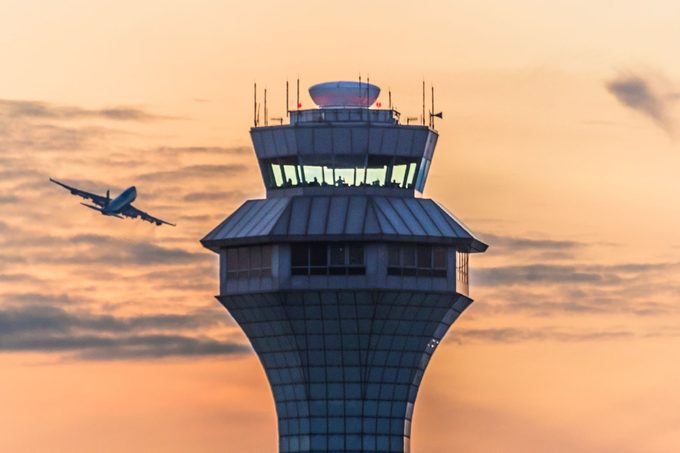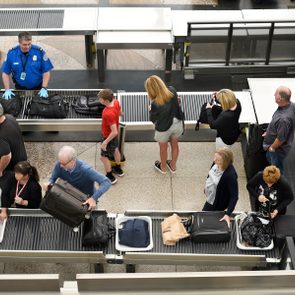Air traffic controllers are in high demand—but is the shortage putting your safety at risk?

New Report: The Most Understaffed Air Traffic Control Towers in the U.S.

It’s hard to miss the blaring headlines: The United States’s air traffic control system is severely understaffed. While high-profile issues like the ones at Newark Airport in New Jersey have pushed the crisis into public view, industry insiders say the problem has been simmering out of sight for a very long time.
A new study by Visual Capitalist reveals just how widespread the shortage really is. Of the 290 FAA-operated air traffic control towers spread across America in 2023 (the most recent year with available data), 128 were considered understaffed, falling below the FAA’s 85% staffing benchmark—a full 44% of towers are currently operating with fewer controllers than optimal.
So what does this mean for airline passengers—and should they be worried? Reader’s Digest spoke with former air traffic controller S. Todd Yeary to break down the causes and risks of the understaffing issue and what might happen next.
Get Reader’s Digest’s Read Up newsletter for more travel, humor, tech and fun facts all week long.
How did air traffic control facilities become so understaffed?
Understanding the current shortage requires first looking all the way back to the Reagan administration. In August 1981, thousands of unionized controllers with the Professional Air Traffic Controllers Organization (PATCO) walked off the job demanding improved working conditions—and were subsequently fired en masse. The FAA scrambled to fill the staffing gap, but the ripple effects of that event are still being felt nearly five decades later. “Staffing has always been a critical issue, but it’s been an ongoing issue in that we haven’t had full staffing of the air traffic control system since the PATCO strike,” explains Yeary, who worked as a controller at the Chicago Air Route Traffic Control Center.
One major factor: The loss of those seasoned controllers meant there were fewer people available to train the next generation. “The mechanisms of training are very involved,” Yeary says. For complex facilities like en route centers, it can take four years or longer from the time a trainee is hired to when they become a certified professional controller. Without that robust training pipeline and mentorship, he says, “It is an ongoing problem that can, and will, worsen over time if there is not a very thoughtful way to mitigate the attrition.”
The COVID-19 pandemic only compounded the problem, further disrupting an already fragile hiring and training system.
Is it dangerous to have air traffic control facilities understaffed?
Thankfully, the biggest impacts of understaffing tend to be operational rather than directly safety related. “The safety risks are few and far between for the most part when we consider [there are] 45,000 aircraft operations every day in the United States,” Yeary points out.
Still, operational strain is a serious concern. “There’s little room for being able to adjust to the unplanned circumstances that occur literally every day in air traffic control,” he says.
Bad weather, like thunderstorms, snow and ice, as well as equipment issues and last-minute flight changes, can put a lot of pressure on the system. “All of it enhances and increases the workload for the controller staff,” Yeary says.
The ever-changing nature of air traffic control requires flexibility and lots of resilience. “Understaffing in a situation that really emerges and originates outside of air traffic control issues themselves can raise a lot of concerns,” says Yeary, who was on the job during the September 11 attacks. He says of that day, “Immediately, we were clearing the national airspace, literally forcing aircraft to land at airports that were not on their flight plan because we did not know how extensive the disruption and the intrusion into the national airspace system actually went. And so, the questions of potential safety risks or operational issues is always a dynamic one.”
Despite the challenges, Yeary says safety is always top of mind at the FAA and the system remains safe. “The redundancy in the system gives us reassurance that, even with the stressors, even with the equipment challenges, even with the staffing needs, there are processes in place that help to maintain a safe National Airspace System.”
When will air traffic control towers be more fully staffed?
“The answer to that question is it is an ongoing and long-term challenge,” Yeary says.
One possible solution: raise the mandatory retirement age of 56 for controllers managing live traffic to reduce the loss of experienced air traffic controllers. Extending that threshold would slow the loss of experienced professionals as new trainees are brought up to speed, Yeary explains.
He also suggests that the air traffic control community should take a page from that of pilots, who use simulators during training. Doing so could lead to more efficiency in the process.
What are the top 10 understaffed major air traffic control facilities, and at what percentage are they staffed?

Staffing shortages aren’t just a local problem—they’re impacting airports across the entire country. From control towers guiding landings to TRACONs (Terminal Radar Approach Control), which oversee regional airspace, these are the top 10 most understaffed major facilities.
1. Oakland Tower, 60% staffed, 40% understaffed
2. Las Vegas TRACON, 67.9% staffed, 32.1% understaffed
3. Milwaukee Tower, 69.4% staffed, 30.6% understaffed
4. Austin-Bergstrom International Tower, 70% staffed, 30% understaffed
5. Rochester Tower, 70.3% staffed, 29.7% understaffed
6. Orlando International Tower, 71.4% staffed, 28.6% understaffed
7. Seattle TRACON, 73.1% staffed, 26.9% understaffed
8. Birmingham Tower, 74.4% staffed, 25.6% understaffed
9. Long Beach Tower, 76.9% staffed, 23.1% understaffed
10. John Wayne/Orange County Tower, 76.9% staffed, 23.1% understaffed
RELATED:
- Traveling to This Airport? Be Prepared for Lost, Damaged or Delayed Luggage
- New Study: These Are the Safest Airlines in the U.S.
- These 12 Airports Will Now Let You Greet Loved Ones at the Gate—But You Need to Do This One Thing First
About the expert
|
Why trust us
Reader’s Digest has published hundreds of travel stories that help readers explore the world safely, easily and affordably. We regularly cover topics such as the best places to visit (and the best times to visit them), tips and tricks to zoom through airport security, flight-attendant secrets, hotel-room hacks and more. We’re committed to producing high-quality content by writers with expertise and experience in their field in consultation with relevant, qualified experts. We rely on reputable primary sources, including government and professional organizations and academic institutions as well as our writers’ personal experiences where appropriate. We verify all facts and data, back them with credible sourcing and revisit them over time to ensure they remain accurate and up to date. Read more about our team, our contributors and our editorial policies.
Sources:
- S. Todd Yeary, former air traffic controller; email interview, June 2025
- Labor History Resource Project (LHRP): “The 1981 PATCO Strike“
- Visual Capitalist: “Mapped: Every Understaffed Air Traffic Control Tower in the U.S.“



